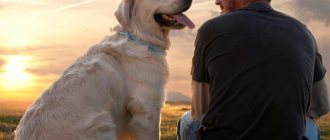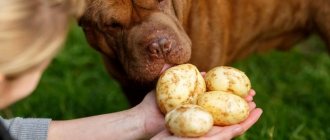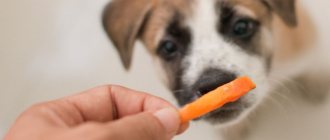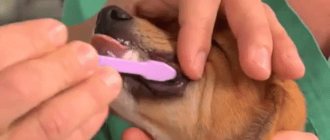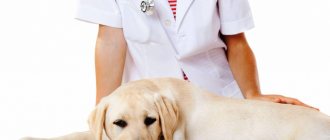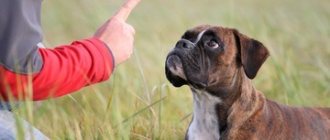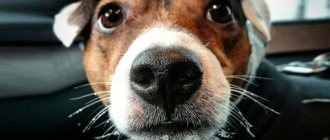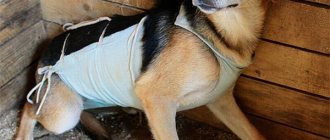What is rhinitis?
Rhinitis is an inflammation of the mucous membranes of the nose; it can be either an independent disease or a sign of other pathologies, for example, infection or allergies. There are several types of disease:
- Spicy. The symptoms are pronounced, the condition occurs against the background of infection with a virus or bacteria.
- Chronic. Appears as a consequence of prolonged exposure to adverse environmental factors or as a complication of the acute form.
- Vasomotor. The reaction occurs at the level of reflexes.
- Allergic. The mucous membranes are sensitive to allergens in the external environment (pollen, dust, etc.).
Many people put rhinitis in dogs and a runny nose on the same level, but in fact, nasal discharge is only a symptom of the disease. This type of disease is called catarrhal rhinitis.
Prevention
You can reduce the likelihood of nasal discharge through preventive measures:
- do not allow your pet to become hypothermic (dogs with short hair, such as Basenjis or Dalmatians, should be dressed in insulated and waterproof overalls during the winter, autumn and spring months);
- do not allow the animal to come into contact with allergens that cause nasal discharge;
- Make sure that your dog does not come into contact with animals suffering from a runny nose (it can be contagious).
Important! A runny nose can be either an independent illness or a consequence of an infectious disease, allergy or pathology.
If your dog has discharge from his nose, take him to the vet. Self-treatment and taking the wrong medications do not always lead to recovery.
Additionally, check out the video about the manifestation and treatment of runny nose in dogs:
source
Causes of runny nose in dogs
The condition occurs for many reasons, most of them are similar to human ones:
- Cold. Animals, just like people, react to hypothermia and drafts. If the dog walked for a long time in bad weather, suddenly left a hot apartment into the cold, slept on a cold floor, the body’s thermoregulation is disrupted, a runny nose, fever, sometimes sneezing, coughing, and fever occur.
- Infection or virus infection. In this case, the first two to three days the discharge will be abundant, liquid and transparent. Next, the green (yellow) snot will become thicker, and the dog will begin to grunt. Your pet may also suffer from conjunctivitis, stool disorders, and vomiting.
- Allergic rhinitis is a reaction of the immune system to an irritant. Most often it is dust, pollen, specific scents, chemicals or shampoos. Clear snot flows, accompanied by redness of the eyes, coughing, and sneezing. Diarrhea and difficulty breathing occur less frequently.
- Aggressive odors can cause a short-term runny nose. The pet will scratch its face with its paws, sneeze, and turn away.
- Foreign object in the respiratory tract. Dogs explore the world through their sense of smell, so it's not surprising that they might accidentally inhale a small object. The dog will try to get rid of it, sneezing, rubbing his nose, shaking his head. Discharge will be observed only from one nostril; if it is damaged, blood may be present in the mucus.
- The presence of neoplasms in the nasal passages (polyps, cysts, tumors). In this case, breathing is difficult, the animal will sniffle, grunt, breathe through its mouth, often rub its face, and pain will appear.
- Mechanical damage, congenital pathologies (fracture of the nose or jaw, cleft palate).
Rhinitis is often caused by weakened immunity.
The body's protective reactions are reduced in young and elderly individuals, pets suffering from kidney, liver or heart diseases, endocrine and genitourinary systems, infection with fleas or worms. Breeds with a flattened muzzle, such as Shar-Peis and Pugs, are more likely to suffer from a runny nose.
Main symptoms - what to look for
What a dog owner can observe with rhinitis:
- Mucus comes from the nose - of varying consistency and shade. Green or yellow-green snot in a dog is a sign of a long course of the disease (longer than 1 week), when bacteria have already appeared (they change the color and consistency of the snot).
- Along with snot, sneezing and attempts to scratch the nose or lick it are usually observed. If you actively try to constantly shake your head, you may suspect the presence of a foreign object in the nose.
- Discharges on only one side may indicate a tumor, polyps or foreign objects.
- With advanced growths of tumor neoplasms, deformation of the bridge of the nose or the entire muzzle may be observed, and ichor may be mixed with the mucus.
- The eyes may become sour and watery eyes may appear (the nasal and lacrimal ducts are combined into the nasolacrimal duct, so all of the above symptoms often occur simultaneously). In some diseases, the eyes simultaneously turn red and conjunctivitis develops.
- Always with rhinitis, the mucous membrane of the nasal cavity swells and becomes very red (this can only be noticed independently in large dogs with large nostrils; in other cases, this is determined by a veterinarian during an instrumental examination).
- Swelling and congestion of the nose are determined by breathing through the mouth - the cheeks are swollen or the mouth is open.
- Curvature of the nose and/or nasal septum due to injury, falls or blows - visible changes in the shape of the nose, the outline of the muzzle, and the tip of the nose.
- In severe illnesses, body temperature may also rise, lethargy and weakness appear, appetite decreases or disappears completely, and thirst appears (if the dog breathes with its mouth open).
For a more accurate diagnosis, you may need to clarify a few more points:
- does the amount of snot change when you tilt your head, during sleep or wakefulness, in the morning/day/evening, is it difficult to breathe after physical activity;
- when nasal discharge was first noticed, and over what period of time it thickened and changed color (if such a fact was noted);
- the discharge is strong or scanty, does it have time to dry out and form crusts around the nose, or is it just constantly wet;
- all the time there was snot coming out of one nostril or two;
- how the dog sleeps - with its mouth open or manages to breathe through its nose;
- does rhinitis cause any inconvenience to the pet or does he not pay attention to it.
Symptoms of rhinitis
While describing the possible causes of the problem, we briefly mentioned the signs of a particular disease. Symptoms may vary, but general features of the disease can be identified:
- presence of nasal discharge (intensity and consistency vary);
- difficulty breathing (you can hear wheezing, snoring in your sleep);
- the dog constantly tries to help itself by touching its nose with its paws;
- sneezing;
- deterioration of smell.
Apathy, poor appetite, and tearfulness also often appear. With a prolonged runny nose, crusts form on the nose. Possible increased body temperature, diarrhea, nausea.
What are the symptoms?
Harmful bacteria cause many causes for the occurrence and development of canine rhinitis. External symptoms are clearly visible: the mucous membrane is swollen and inflamed, clear mucus is released in large quantities, or cloudy discharge from the nostrils.
If the problem is not addressed in time, a runny nose can develop into a chronic or purulent one, as a result of which a thick green or gray substance (sometimes with blood) will constantly be released. Diseases caused by viruses have more pronounced symptoms:
- The skin around the nostrils may become scabby;
- the skin around the eyes becomes inflamed;
- breathing becomes difficult, the pet begins to cough and sneeze excessively;
- loses appetite, can lie for a long time without moving;
- If there is no help for a long time, the temperature may rise and severe wheezing may occur in the chest area.
If the infection that arises is left unchecked, the pet’s life begins to be in serious danger.
The main effective way to combat it is considered to be vaccinations, which are carried out every year.
How to treat runny nose in dogs at home?
You can treat snot in a dog at home, but a doctor must still prescribe it. He will determine the cause of rhinitis, prescribe medications in accordance with it, and, if necessary, take additional tests. Before the doctor arrives, the owner can do the following:
- A flashlight will be a great help to examine your pet. Assess the presence of discharge, its color and consistency, and intensity. Observe your dog for other symptoms. You will tell the doctor about all this.
- Clear your nose of mucus and crusts. To do this, wrap gauze or a cotton pad around your finger and, if necessary, moisten it with warm water.
- You can give your dog a chamomile decoction or treat the nasal passages with it. Taking an infusion of the herb internally soothes, applying it to the mucous membranes relieves itching and has an antiseptic effect.
- Make sure that the animal does not aggravate its condition by being in a draft or frost. Walking your dog when you have a runny nose is minimal.
- Offer your pet to drink more, preferably warm water. The food remains familiar.
The doctor will prescribe medication. Depending on the provoking factor, it may be necessary to exclude the allergen from the diet or the external environment, take antihistamines, remove a foreign body from the passages, or surgically remove tumors. But in most cases, a runny nose is caused by a cold, then nasal medications, warming and rinsing the sinuses are most often used to relieve the symptom.
Nasal drops
The most famous nasal drops for a runny nose for dogs are Maxidin. Doctors allow you to give them yourself, the main thing is to take into account the instructions for use. The drug has an antiviral and immunomodulatory effect. Used in the treatment of plague, parvovirus, enteritis, and helminthiasis. They help with skin diseases and are often prescribed as a preventive measure. If you start giving Maxidin at the first appearance of snot, you can prevent the spread of infection. Drop the solution 2 drops 3 times a day.
Another well-known remedy is Anandin. An intranasal drug used to treat rhinitis and conjunctivitis; accordingly, it should be instilled into the nose or eyes, depending on the problem. For a runny nose, it is recommended to use the product three times a day, the dose depends on the weight of the animal, ranging from 1 to 4 drops. Long-term therapy is addictive, so the duration of the course is no more than 14 days.
The use of human drops such as Naphthyzin or Sanorin is strictly prohibited. In the chronic form of the disease, you can drip menthol oil.
Warming up
One of the effective methods of facilitating an animal's breathing is warming up. You need to take a sock or scarf, heat salt or sand in a dry frying pan, pour it into the fabric. The compress is applied to the bridge of the nose for 3-4 minutes. Remember, it is better to do short-term but frequent procedures. If home treatment is not enough, physical therapy can be provided through a veterinary clinic.
Do not overheat the salt; too hot a product can cause burns.
Washing
It is necessary to rinse your dog's nose when he has a runny nose. Firstly, it cleanses the airways and removes mucus. Secondly, it is a preventive measure against the spread of infection. You can use pharmaceutical remedies or traditional methods, including:
- Soda solution, prepared at the rate of 1 tbsp. water for 1 tsp. sodium carbonate. The liquid should be warm. On the advice of a doctor, you can add a few drops of iodine to the mixture.
- Infusions of chamomile, St. John's wort, coltsfoot, violet and calendula are used. They soothe and disinfect mucous membranes. Add 1 tsp to a glass of boiling water. herbs, let it brew, cool and strain the solution.
- Beetroot juice for instillation is diluted with water in a 1:1 ratio.
- Some owners use onion juice to treat a runny nose, but you need to be careful with it; sensitive mucous membranes may become irritated. The secretion of one vegetable is squeezed out and mixed with water in equal parts. Cotton swabs are soaked in the solution and inserted into the nostrils for 10-15 minutes. The duration of treatment depends on the severity of symptoms.
- It is allowed to use sea water for washing: Aqua Maris, Aqualor, Dolphin.
- On the advice of a doctor, a solution of furatsilin (0.1%) is used.
Whatever medicine or remedy you choose, first assess the dog's condition. If the snot flows, you can limit yourself to simple rinsing. If your nose is stuffy or a lot of crusts have formed, you must first soften them. To do this, use turundas with petroleum jelly, glycerin, and 3% hydrogen peroxide. Oxolinic ointment has a softening and antiseptic effect; it is effectively used at the first signs of a cold.
It is allowed to use Evamenol ointment. Its composition is completely natural: menthol, eucalyptus oil, petroleum jelly. It is most convenient to apply the product with cotton swabs; keep in mind that dogs do not like such procedures, so it will be good if someone can hold the dog.
In the chronic form of the disease, on the contrary, it is necessary to dry the skin around the nose. For this purpose, special powders are prescribed, including streptocide powder.
How to help if snot is detected
A runny nose is not a separate disease, it is a symptom that something is going wrong in the body. Treatment of snot in dogs will directly depend on the cause that provoked it. Final comments are always up to the specialist!
Allergy
With a true allergy, sneezing and lacrimation are added to the snot. Possible itching and rash on the body. What is characteristic is that the nasal discharge is serous (transparent, liquid), tears do not sour in the corners of the eyes.
The nose does not need to be rinsed, but antihistamines must be prescribed:
- diphenhydramine (0.3-1 ml/kg of animal weight, depending on size, up to 2 times/day);
- tavegil (0.5-1 tablet per animal every 12 hours);
- diazolin (after feeding 1-3 tablets or tablets, depending on the size of the dog, once or twice a day);
- suprastin (1/2-1 tablet 1-2 times a day, depending on the size of the dog and the response to the drug).
In particularly protracted cases, hormonal and/or steroid drugs may be prescribed.
Cold
Resting on a draft or cold floor often affects your pet's health. In acute rhinitis, when the snot is clear and watery, frequent rinsing is not required. It is enough to use Derinat or Pinosol nasal drops (herbal oil-based preparations) - 2-3 drops 2-3 times a day for up to 2 weeks (but usually 7 days are enough). You can place bags of warm sand, salt or buckwheat on the bridge of your nose to warm it up - up to 3 times a day.
It is forbidden to use heating if the snot is green and thick!
If the snot thickens, turns yellow-green and begins to dry around the nose, be sure to carefully remove the crusts before washing and instilling them (use 3% hydrogen peroxide or a mixture of glycerin and vitamin A). Rinse your nose well with a mixture of 1% soda and 0.5% tannin (1:1). Drip chloramphenicol eye drops - 2 times a day, 2-3 drops, for no longer than 10 days.
Vasoconstrictor drops are not used for dogs! Human drugs such as Galazolin, Naphthyzin, Sanorin, Nasol are especially not recommended for use!
Foreign bodies
Dogs love to dig for things and literally stick their noses everywhere, so blockage of the nasal passages by a foreign body is not uncommon. This can be understood by snot from only one nostril (mostly), wheezing breathing, or no air movement at all from the clogged side. In addition, the dog may shake its head and rub its muzzle with its paw, clearly making it clear that something is wrong.
If the dog is large with large nostrils, the object is visible, and the owner has no doubt about removing it on his own - you can try to act. When lighting the nasal passages, be sure to cover your dog's eyes! But the most correct action is to seek help from a specialist. The peculiarity of the structure of the dog’s nasal passages is such that if a foreign body is ineptly removed, there is a risk of pushing it even deeper into the nasopharynx.
Tumors, polyps
After examining the nasal cavity and muzzle, a decision is usually made to remove the tumors. The type of tumor, size and nature of the tumor can only be determined by a specialist. New growths that cause deformation of the bridge of the nose or the muzzle as a whole are worthy of special attention.
Before the operation, it is necessary to conduct additional studies to correctly select anesthesia and surgical tactics. Rhinitis usually goes away after the tumor is removed and postoperative wounds heal.
Infectious diseases
Only a veterinarian can determine the type of infection, especially since the causative agent can be not only viruses or bacteria, but also fungi. Specific therapy is prescribed, depending on the type of infection - antiviral, antimicrobial or antifungal drugs. At the same time, general strengthening agents and stimulating immunity are recommended.
Nasal rinsing is indicated when the discharge is thick, yellow-green and makes breathing difficult. Therapeutic drops are used similar to those used for colds (Pinosol, Derinat, chloramphenicol eye drops). To increase local immunity of the nasal mucosa, Thymogen drops are often prescribed - 2-3 drops to a dog weighing up to 10 kg once a day for 7-10 days.
What to do if your dog grunts?
If there are no obvious symptoms of a cold or allergy, but the dog sniffles or snores in its sleep, it is necessary to find out the cause of the phenomenon and begin appropriate treatment:
- Polyps and other neoplasms. Small growths may not be noticed; only difficulty breathing will indicate their presence. When large tumors appear, the teeth will begin to loosen, frequent nosebleeds will occur, and in the later stages the muzzle will become deformed. The problem cannot be solved with pills; surgical intervention is necessary.
- Adenovirus is one of the common and dangerous infections, one of the symptoms of which is rhinitis. The discharge will be cloudy in color and a frequent cough will begin. The disease is only combated by antibiotics and supportive care.
- Allergic rhinitis can only be treated under medical supervision. If the allergen can be excluded, this must be done; if not, for example, a reaction to pollen occurs, the veterinarian will prescribe a course of treatment with antihistamines. In this case, the owner will only need to rinse the pet’s nose.
The occurrence of rhinitis is a signal to the breeder that the pet’s immune system is weakened and needs to be strengthened. Often in dogs of small breeds the body’s protective properties do not cope. They need to be stimulated with vitamins (A, E, C, group B), the veterinarian can additionally prescribe immunomodulators (Immunofan, Immunal, Cycloferon, Gamavit).
Video: how to treat a runny nose (rhinitis) and snot in a dog at home?
Prevention of runny nose in dogs
In most cases, inflammation of the mucous membranes of the nose is caused by a cold. It can be easily prevented if you follow these recommendations:
- Provide the animal with proper care: a balanced diet and sufficient exercise. Remember that if you feed your pet natural food, it is better to give additional mineral complexes. If you prefer dry food, buy professional brands. Always consider your friend's breed; Jack Russell Terriers and Corgis require different levels of exercise.
- Walk your animal regularly (at least 2 times a day), with the exception of bad weather.
- Avoid hypothermia at home and outside. In the apartment, the dog should have a bed; it is located in a place protected from drafts. The dog is not taken for a walk after bathing; in the cold season, insulated overalls are worn.
- Hardening helps strengthen the immune system and improves the general condition of the body. The main thing is to gradually increase the time you walk in the cold.
- Do not ignore annual vaccinations, they strengthen the immune system and protect against the most dangerous infections. It is also advisable to take your dog to the veterinarian once a year and undergo general tests.
- A runny nose can be a symptom of a viral disease that was contracted from another animal. Try to protect your pet from contact with sick individuals.
Following these recommendations will make your pet's body stronger. If you are all faced with rhinitis, do not delay treatment, do not allow the disease to progress.
